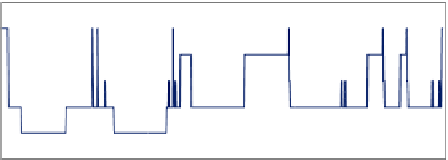Biomedical Engineering Reference
In-Depth Information
wake
REM
NREM 1
NREM 2
SWS
0
100
200
300
400
500
600
700
800
900
Time (epochs)
Fig. 1.
Sample hypnogram from the present study
by other physiological signals [24], including heart rhythms via electrocardiography
(ECG), and muscle movements via electromyography (EMG). A stage of sleep associ-
ated with dreaming, the Rapid Eye Movement (REM) stage, was subsequently identi-
fied [1], [11], leading to currently used staging standards [31], [18] that comprise the
light sleep non-REM (NREM) stages NREM 1 and NREM 2, a deep sleep (slow-wave
sleep (SWS)) stage or stages NREM 3/4, and REM sleep. Neuroimaging techniques,
including fMRI and PET, have yielded specific information about brain activity in dif-
ferent regions of the brain during each of these sleep stages [9].
Sleep Architecture.
Sleep normally progresses through the various stages during the
course of a full night, albeit in a manner that is not predictable in detail. A sample
diagram of the temporal progression of human sleep stages during the night, known as
a hypnogram, is shown in Fig. 1. This particular diagram was generated from one of
the
244
polysomnographic recordings used in the present paper. Some typical features
to note are: most SWS (stages 3 and 4) occurs earlier in the night, a greater amount
of REM sleep occurs later in the night, REM and stage 2 alternate semi-cyclically, and
there are brief periods of wakefulness throughout the night, after the initial onset of
sleep. Despite some common features across individuals, the detailed structure of sleep
is known to vary from person to person, and is affected by a variety of factors, from
such fundamental physical attributes as body composition [30] and handedness [28], to
behaviors such as smoking [35] and the practice of yoga [33].
Description of Sleep Structure.
Sleep structure is frequently described in terms of
sleep stage composition, that is, in terms of the fraction of time accounted for by various
sleep stages within a night of sleep (e.g., [10] and [20]). While sleep stage composition
provides a good global summary of overall sleep stage content, it does not capture any
information about the duration and ordering of uninterrupted episodes of different sleep
stages during the night, which are important features of sleep architecture.
Sleep stage durations have previously been used to describe alterations in sleep dy-
namics due to health status or ingested neuroactive substances. For example, in [7],
it is shown that sleep stage durations are affected in specific ways by age, caffeine,
and hypnotic drug withdrawal. Obstructive Sleep Apnea (OSA) is shown to alter sleep
stage dynamics in [27] and [4]. Differences in mean duration of stage 2 bouts between
patients with fibromyalgia and normal control subjects have been described in [6]. Ex-
ponential and power-law functions have been proposed as models for the stage duration





















































Search WWH ::

Custom Search